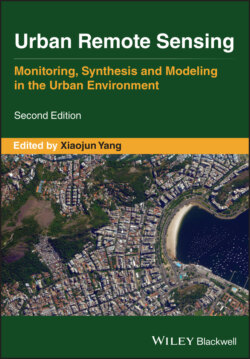Читать книгу Urban Remote Sensing - Группа авторов - Страница 31
2.3 LIGHT DETECTION AND RANGING (LIDAR) APPROACHES 2.3.1 BACKGROUND
ОглавлениеAirborne discrete‐return lidar is the de facto data standard for urban built‐up height estimation and volume calculation in research and in practice because it rapidly captures highly detailed 3D data for relatively large areas with minimal vertical error (Dong and Chen 2018). In fact, lidar data commonly are more accurate in the vertical dimension than the horizontal (Cheuk and Yuan 2009). Significantly, discrete‐return lidar data collection records multiple returns for each laser pulse sent toward the Earth's surface and laser pulses can penetrate vegetative canopy gaps (unlike passive, optical data). Lidar, therefore, captures terrain data beneath canopy as well as structural information about the canopy itself (Shan and Toth 2018). However, for urban applications emphasizing built‐up infrastructure, this is not as important as acquiring rooftop heights and structures – although in residential areas tree canopies often overhang rooftops of homes where multiple returns are important for vertically separating the two.
From a broader urban remote sensing perspective, lidar data provide a wealth of information on urban infrastructure applicable to many research topics such as small area population estimation (Dong et al. 2010; Zhao et al. 2017), urban feature extraction (Priestnall et al. 2000; e.g. roads: Boyko and Funkhouser 2011, building footprints: Rottensteiner and Briese 2002), visualization (Palmer and Shan 2002; Habib et al. 2008), and through a variety of change detection applications (e.g. pre‐/post‐disaster: Dong and Guo 2012, buildings/building types: Dong et al. 2018, etc.). In addition, given its importance in improving air quality and human health outcomes among other benefits, tree canopy delineation and quantification is also a common application for lidar data in the urban environment (Alonzo et al. 2014; Ellis and Mathews 2019). Regardless of application within urban research, lidar data handling is similar (see next section for data processing and analysis details).
Specific to this chapter on built‐up volume, research focusing on buildings is of special interest. For example, Dong et al. (2010) and Zhao et al. (2017) use lidar data to calculate building volume for portions of several Texas cities (Dong et al.: Denton; Zhao et al.: Austin, Dallas, Houston, and San Antonio) to estimate population with the assumption that higher building volumes signify increased population. Both studies extracted buildings from lidarderived raster data to explore how built‐up volume relates to several US Census population datasets. Results of regression analyses indicate that built‐up volume can serve as a proxy for population with moderate to high success. Although from remotely sensed data alone, complexities of land use are difficult to resolve – i.e. large industrial buildings might indicate many people work at these locations but does not mean they reside there (Zhao et al. 2017). Other urban remote sensing studies implement rasterized lidar data to demarcate building footprints by way of height thresholding and masking (Rottensteiner and Briese 2002) or through image classification techniques (Priestnall et al. 2000). Evaluation of built‐up change requires differencing of multi‐temporal 3D datasets along with additional efforts to extract and characterize types of change (Vu et al. 2004; Stal et al. 2013; Teo and Shih 2013; Dong et al. 2018).
